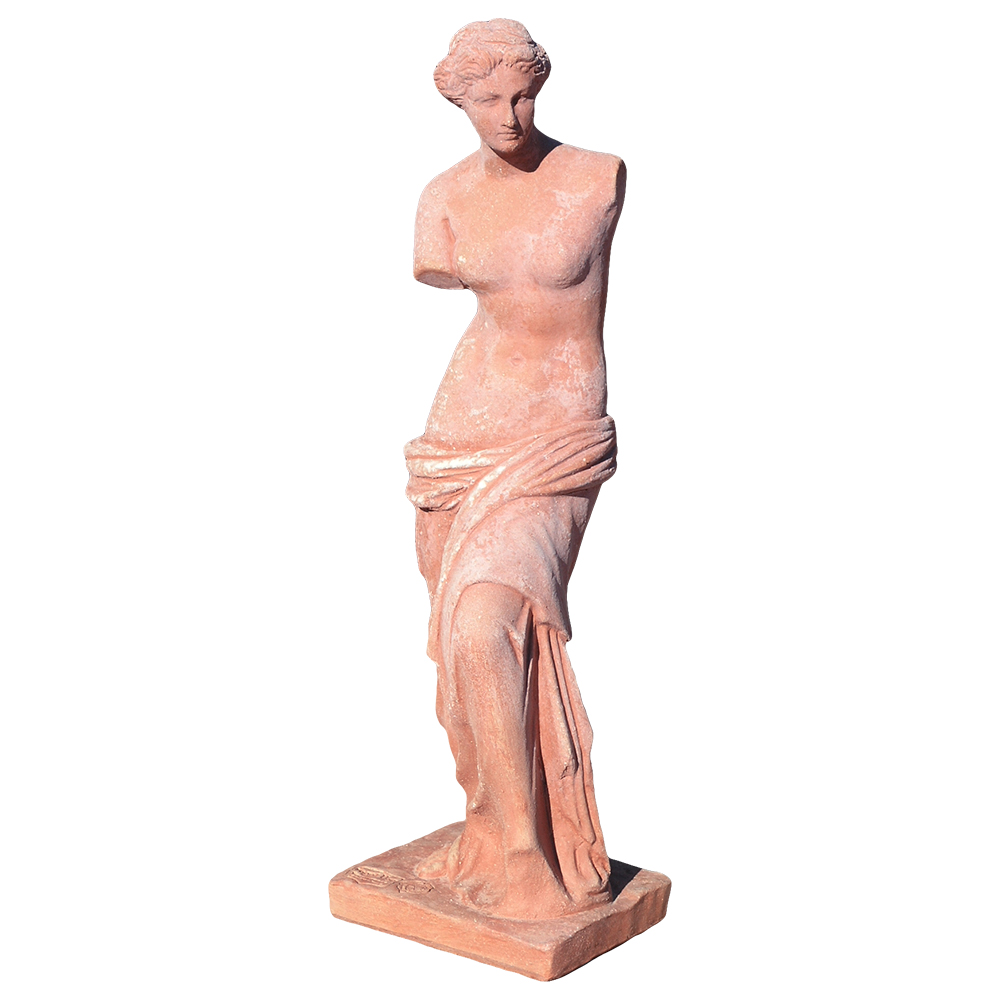-
×
 Bust of Michelangelo's David H 35cm
1 ×
Bust of Michelangelo's David H 35cm
1 ×€350,00€245,00 -
×
 Pair of Emperador and Nero Marquinia Marble Columns H 100cm
1 × €1.920,00
Pair of Emperador and Nero Marquinia Marble Columns H 100cm
1 × €1.920,00 -
×
 Roman Travertine Marble Capital
1 × €990,00
Roman Travertine Marble Capital
1 × €990,00 -
×
 Calcatta Marble Column H 100cm
1 × €990,00
Calcatta Marble Column H 100cm
1 × €990,00 -
×
 Medicean Marble Vase Salome H 40cm
1 ×
Medicean Marble Vase Salome H 40cm
1 ×€790,00€553,00 -
×
 Virgin and Son in Garland Wall Decoration Ø 38cm
1 × €189,00
Virgin and Son in Garland Wall Decoration Ø 38cm
1 × €189,00 -
×
 Bust of Mary Conception Marble Sculpture H 30cm
1 × €223,00
Bust of Mary Conception Marble Sculpture H 30cm
1 × €223,00 -
×
 Madonna and Child Terracotta Wall Decoration H 24cm
1 ×
Madonna and Child Terracotta Wall Decoration H 24cm
1 ×€69,00€48,30 -
×
 Pair of Sahara Noir Marble Columns Italian Interior Design H 100cm
1 × €1.920,00
Pair of Sahara Noir Marble Columns Italian Interior Design H 100cm
1 × €1.920,00 -
×
 Fireplace Frame in Antique Leccese Stone Carved by Hand
1 × €4.900,00
Fireplace Frame in Antique Leccese Stone Carved by Hand
1 × €4.900,00 -
×
 Pair of Black Aquitaine Marble Obelisks H 56 cm
1 × €520,00
Pair of Black Aquitaine Marble Obelisks H 56 cm
1 × €520,00 -
×
 White Carrara and Brown Marble Julius Caesar Bust
1 × €3.600,00
White Carrara and Brown Marble Julius Caesar Bust
1 × €3.600,00 -
×
 Venus de Milo Statue
1 × €189,00
Venus de Milo Statue
1 × €189,00
Venere di Milo Scultura in Marmo Grigio Base in Alabastro H 40cm
€209,00 €146,30
Gray marble sculpture with alabaster base. Each Sculpture is unique in the nuances and details of the forms, slight variations from the image are to be considered a guarantee of the uniqueness of the object and materials. Special processing that makes the sculpture matte, anti-reflective and original. Marble is a solid and aesthetically beautiful fine material. In the contemporary perspective...
- Gray marble sculpture with alabaster base.
- Each Sculpture is unique in the nuances and details of the forms, slight variations from the image are to be considered a guarantee of the uniqueness of the object and materials.
- Special processing that makes the sculpture matte, anti-reflective and original.
- Marble is a solid and aesthetically beautiful fine material. In the contemporary perspective of Ethics and Sustainability, Marble production is capable of creating unique works that convey visual and tactile emotions.
- A refined and symbolic work of great elegance and strong visual impact, it ennobles any environment with its scenic presence.
- The need to decorate rooms originates in the oldest traditions. Through objects and decorations we can express our personality and can change the atmosphere of a room with just a few touches and without substantial intervention.
- Venus of Milo is not an eternal symbol of beauty, love and harmony. Decorating one’s space with this sculpture elevates the aesthetics of the environment and enriches daily life with profound and universal meanings.
SUBJECT
Venus of Milo is one of the most famous and iconic sculptures of antiquity, representing the ideal of classical beauty. Created around 130-100 BC, this marble statue depicts Aphrodite, the Greek goddess of love and beauty, known to the Romans as Venus. Discovered on the island of Milos in 1820, the sculpture is currently on display at the Louvre Museum in Paris, where it continues to fascinate millions of visitors each year. The Venus de Milo is a representation of female beauty in an idealized form. The goddess is depicted without her arms, which are believed to have originally been raised in a gesture that symbolized grace and divine power. Her posture, with her slightly tilted torso and delicately draped drapery, expresses timeless elegance, embodying the perfect balance between strength and softness, movement and stillness.
SYMBOLOGY.
Aphrodite, goddess of love, represents not only physical beauty but also the power of attraction and harmony. The sculpture symbolizes the aesthetic ideal of the Hellenistic era, a time when Greek art sought to capture human and divine perfection. This ideal is reflected in the proportion of the body, serenity of expression and delicacy of detail, conveying a sense of calm and perfection. The presence of this sculpture lends a touch of elegance and refinement to any setting. Venus de Milo, with its timeless beauty, becomes a focal point in a room, drawing attention and stimulating admiration. In addition, the sculpture instills a sense of tranquility and harmony in the space. Its depiction of Aphrodite as a symbol of love and beauty can positively influence the atmosphere of a home, promoting a serene and welcoming environment. Another important aspect is the connection to culture and history. Having a reproduction of the Venus de Milo is not only a matter of aesthetics, but also a way to connect with the past and appreciate the artistic heritage of antiquity. This can enrich the home environment with cultural depth and a sense of historical continuity. Finally, the Venus de Milo can also serve as personal inspiration. Her beauty and perfection can remind us of the importance of seeking and appreciating beauty in daily life, not only in art, but also in the es
THE MATERIAL.
A timeless sculpture, it combines elegance and modernity and is easily paired with antique furniture, dark and fine woods, as well as innovative materials, such as glass and concrete, favored by modern interior design concepts.
This Work expresses at its best the immense creative and structural possibilities of natural stone, especially when the skilled hand of true craftsmanship, a symbol of the excellence of our entire Made in Italy tradition, is behind it.
Marble has always held a place of honor in interior and exterior architecture and decoration. A material that has always been used in a wide variety of fields, from large-scale construction and sculpture to everyday and domestic use. Thanks to its durability and versatility, complements, decorative objects and even utensils made of marble become immortal and lend an undisputed touch of elegance to any room and decor, from classic to modern.
| Dimensions | 40 cm |
|---|
You may also like…
€19,90 – €94,00
€189,00
30%

 Italiano
Italiano

 Bust of Michelangelo's David H 35cm
Bust of Michelangelo's David H 35cm  Pair of Emperador and Nero Marquinia Marble Columns H 100cm
Pair of Emperador and Nero Marquinia Marble Columns H 100cm  Roman Travertine Marble Capital
Roman Travertine Marble Capital  Calcatta Marble Column H 100cm
Calcatta Marble Column H 100cm  Medicean Marble Vase Salome H 40cm
Medicean Marble Vase Salome H 40cm  Virgin and Son in Garland Wall Decoration Ø 38cm
Virgin and Son in Garland Wall Decoration Ø 38cm  Bust of Mary Conception Marble Sculpture H 30cm
Bust of Mary Conception Marble Sculpture H 30cm  Madonna and Child Terracotta Wall Decoration H 24cm
Madonna and Child Terracotta Wall Decoration H 24cm  Pair of Sahara Noir Marble Columns Italian Interior Design H 100cm
Pair of Sahara Noir Marble Columns Italian Interior Design H 100cm  Fireplace Frame in Antique Leccese Stone Carved by Hand
Fireplace Frame in Antique Leccese Stone Carved by Hand  Pair of Black Aquitaine Marble Obelisks H 56 cm
Pair of Black Aquitaine Marble Obelisks H 56 cm  White Carrara and Brown Marble Julius Caesar Bust
White Carrara and Brown Marble Julius Caesar Bust  Venus de Milo Statue
Venus de Milo Statue 













